FROM SASHA WITH LOVE: Sasha Rayevskiy draws from his Russian heritage and graffiti roots to create vivid, whimsical works
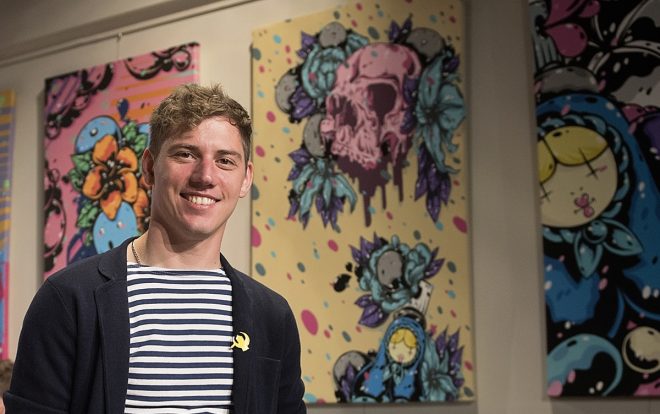
INTERVIEW / DONNA SMITH
PHOTOS / MEREDITH MASHBURN
Several years ago, artist Sasha Rayevskiy and I were roommates. Coming from Jonesboro and wanting to expand the art scene in the area, Rayevskiy has called Northwest Arkansas home for just a few short years, and it’s amazing to see how much his work has developed in that time. It was my pleasure to catch up with Rayevskiy at Onyx Coffee, the site of his #prententiouscoffeechronicles series, during a very brief break he had from completing murals and gearing up for his first solo exhibition in several years. Basically, the things that make him one of the hardest-working and most driven creative minds I’ve ever met.
DS: Could you talk about some recent projects you’ve finished? Do you feel that as you’ve been pursuing your work, your network of people that know you and know your work has grown also? Do you find that more people are coming to you instead of you seeking projects out first? Or is it a mix?
SR: For the past four months it’s been chaos. Yeah, it went from putting everything into my store and not working, to being constantly busy doing commissioned works, working with NWA Fashion Week on panels, and even doing a mural piece for UniLever at the Bentonville Film Festival. I finished a piece for Harry’s in downtown Fort Smith and worked with Jeff Gosey, who runs Peacemaker Festival.
I think as my style has refined and grown, people know I can execute different projects. Working on things digitally, through my stickers and other projects, has given me a way to promote work too. And sometimes, it’s just good timing. For example, I met a person who wanted me to do some paintings with flowers. While I had wanted to experiment with those forms for years, I just didn’t have a project or that specific thing to try those out on you know? So, it kind of just worked out. I also made [only] two paintings in 2017, and now I’ve got so many different projects that I’ve completed [in 2018]. You just have to be ready to take advantage of those opportunities and meet with people who are interested in your work.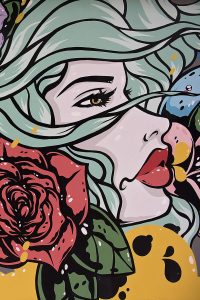
I know for some artists, the idea of creating a mural for a thirty-foot wall can be overwhelming. I’m wondering if you might be the opposite. Many of your works of late have been on a large scale, but I know you also make standard-sized pieces too. How does your process change when thinking about size and scale? Do you enjoy one over the other?
For me, the process isn’t really that different. I mean, I’ve learned efficiency in large scale works, which partially has come from working with my dad, who has experience as a commercial painter. I have a lot of knowledge of different paints and how they can or can’t be applied to different kinds of walls.
Whether it’s a small scale painting or a mural, I like to freehand first and that way, it’s open to changes before the paint goes on. Murals can be fun because of the recognition and the change in the space and interaction that comes along from working in public. I like to use smaller works for testing out other ideas. As I’ve developed, I’ve found a process that works for me and figuring that out does change how you approach a project, so that you can tackle anything.
Just from knowing you and following you on Instagram (@tigersasha), it is clear that you have been super busy. It’s not even the halfway point of the year and I bet you have many other things in the works. What are some of the projects or works you’ll be creating for the second half of 2018?
SR: I am in the process of putting together my first solo show since my last one at the Shed and that should be happening this August [through October] in Bentonville at Fellow Human.
You are on the go constantly! Whether it’s creating a mural for UniLever at the Bentonville Film Festival, a commission in Dallas, or various places across the country, you’re hitting up a lot of places. What are some of your favorite areas to see and/or create art and where would you like to travel in the future?
I really enjoyed going to Art Basel in Miami a few years ago and would love to get more opportunities there—that’s sort of my next stage in planning as I think about expanding my network. I also love Cincinnati, there are so many interesting things happening there. It’s just a cool place.
This Spring you were chosen to be an Artist INC fellow through the program in Springdale. What benefitted you most from the program and what would you say to artists looking to apply for the next cycle?
I’d say the connections you make are the greatest benefit. Like, 70% of the people in the program, you know, but you’ve never met. I was able to meet other great artists like Kat Wilson and Meredith Mashburn through that and now we’ve collaborated, or they’ve been awesome enough to photograph me working. So yeah, in the program, you’re encouraged by everyone to talk about your work and potentially work together on a project too. It’s also cool to see how other people create and how they talk about it. It’s important to get information from the program too about legal contracts, how to get ideas out there, etc.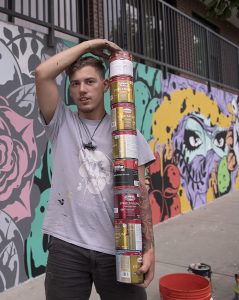
What artists do you admire and what do you like most about them?
I didn’t really start looking into other artists until I was in high school. I kind of had my own style and learned by practicing. It wasn’t until a teacher shared that I should look at Derek Hess that I started researching and then found artists like Kandinsky. I also look at Instagram a lot, specifically at graffiti artists and their works. With spray paint, I started out and it took several years to learn different lines and styles. After getting into it, I was in the middle of the work and started seeing more and more public art and finding artists like Tristan Eaton. He’s a big inspiration and I’ve had the pleasure of meeting him in person as well. It was down in Miami and it seemed like he was surprised that I knew who he was! It was a complete accident that we just happened to be on the same street where he was working.
As we were once roommates, I know that we have experienced the art scene growth in NWA together. Since living here, what are some of the positive aspects you’ve witnessed and what do you think we could be doing more of or planning more for in the future for artists in the area?
Once I moved to Fayetteville, that was really when I started doing murals. I think Jason Jones and myself were [the two] that I knew of doing work like that. But now Brandon Bullette has [started] creating murals, and of course Matt Miller has been doing them for a while, so seeing others working can cause you to think bigger or think outside of what you’ve typically been doing. I think the inclusion of other makers and creative people is really growing in the area. Other artists are coming out to shows to support each other too.
It will take time to show the value of our local art. But, I can see it’s growing through the increase of local work and thinking about other places in the state too. Like, with Jonesboro, if you look back several years ago and what the scene is like now, it’s awesome. Just like with Little Rock—the whole state really—it’s becoming more of a community for artists. We do need more spaces to work in the studio. For example, Denele Campbell’s spaces on Center Ave. [in Trailside Village] are places that breed creative ventures, purely out of those studios being available and affordable.
At different times, you have played in bands, provided projections for djs, planned events, operated Blk Mkt streetwear shop, worked as a bartender at Smoke and Barrel, you restore cars, and you even worked at Washington Regional Hospital, all while keeping up your studio practice. How do these various interests and experiences play into your artworks and how do you find balance between your work and living your best life with family, friends, partners, and Leon, your amazing dog?
It was a really big decision to leave my store (Blk Mkt) and take on my art full-time. But, you also can’t grow if you have all these opportunities for your work and you can’t accept them or take them on because you have to be at a job from 8-5. You only have so much time to work. I originally wanted to be a touring musician, but even though that fell through, I still love playing. I just look at music as a different aspect of my practice. Right now, I really only have time for visual art and my personal life. There isn’t time for an extra job or something like that. It’s been great to have the support of people in my life as well.
[Having a lot of work] just means you have to prioritize and give dedication to what you want to do. Income can be tough. If I think back to five years ago, I would go to my job, work in the studio, then sleep for three hours and start it all over the next day.
I think that whether it’s art, music, or sports, they all have techniques, they all play into each other as well. I use old song titles for painting titles. I just get to exercise my brain in another way when I’m playing or working out of the studio. Having the store definitely helped me learn the business side of things, which can be a lot. You just catch more traction once you know how to use those skills to market yourself.
I do enjoy cars, but that’s just a hobby. Sundays are for cars.
What is a work or a project that you’d love to work on or create? Let’s say there are no limitations financially, geographically, etc.
I’m kind of already working on it! I would love to make vinyl figurines, specifically of Russian nesting dolls and the bubble figures I’ve created. I’d like to use those as a way to talk about Russian culture, being that there could be some misunderstandings or lack of knowledge on what they stand for or mean. It’s a way to bring it up, using an art object as a way to talk about something deeper.
I’d also like to illustrate a children’s book, collaborating with writers. It might be about growing up as an immigrant, using the nesting doll as a character. It could involve other Russian fairy tales too.
With the #prententiouscoffeechronicles series, I’d like to turn that into a fundraiser for kids. My partner, Gracie Kloss, donates her time to Camp Hope, this amazing center for kids who have tested positive for HIV, providing training and support for them. It really just brightens the kids up, because, someone is genuinely giving them their care, when HIV still has an unfair stigma, and it also gives something back to you as well. I think it would be great to travel to different places around the country, different coffee shops, and create specific pieces there to sell, and raise that money for charity. Then, for some of the drawings, I could screen print editions and sell those. Maybe we could even do a video series to raise awareness through my travels.
You recently became a United States Citizen! How was that process and do you find that your experiences working in the US have changed or shifted before and/or after that process?
Long, tedious, and expensive! It’s nice to be done. I finally got a passport—I haven’t had one in 20 years. It’s tough because you have to renounce your prior citizenship elsewhere. It’s a relief, but also an odd sensation. I moved here and didn’t have a lot or know a lot of English. When I went to NYC for example, you could select the Russian language at a kiosk, but not here.
I wish I could say to people, “Here’s what the country is actually thinking.” There are a handful of movies that are translated correctly. Our cultural and art history is vast and Russians are their own type of people. There were a lot of misunderstandings in my adaptation here to the states, but I still grew up in a Russian household and was glad to do so, despite the cultural differences.
DS: I love seeing your sketchbook. It looks like each of the drawings you make could easily be ripped out and put on a wall. What do you enjoy about sketching and how does that fit into your art making process?
Sketching is one of the best things I’ve ever done. It’s the importance of making yourself do something, like, “I need to make something” today. Not enough people do that and, of course, some days are better than others.
DS: In this great love of art, there are so many setbacks that can and do happen. How do you stay motivated when experiencing a failure and how do you measure success? Could you describe a time when you had to bounce back from something and how you continued on?
SR: I look at success as how much I’m able to get accomplished. I set small goals, even with things like cars. Those then hopefully lead to larger projects, making money, being accepted, etc. It can be discouraging and you just have to work through it. At a point last year, I felt like Fayetteville let me down. Raising the bar really motivates me and those people raising it, I look up to. I’ve just been thinking bigger. I think better collaborations between local and international artists can help too. The act of working together exposes cultural differences and different methods of working, which is great! At the end, you can’t have success without failure. If you don’t know how to measure it for yourself, you don’t know how to improve.
TIGERSASHA.COM
#FROMSASHAWITHLOVE


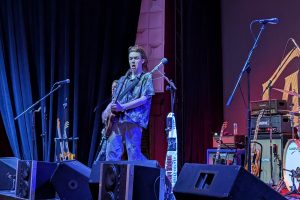
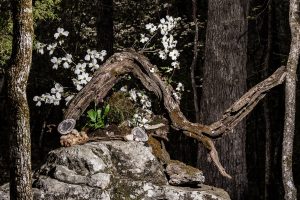
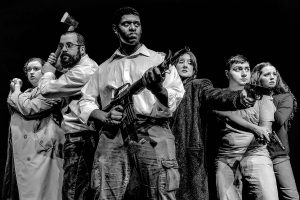
Comments